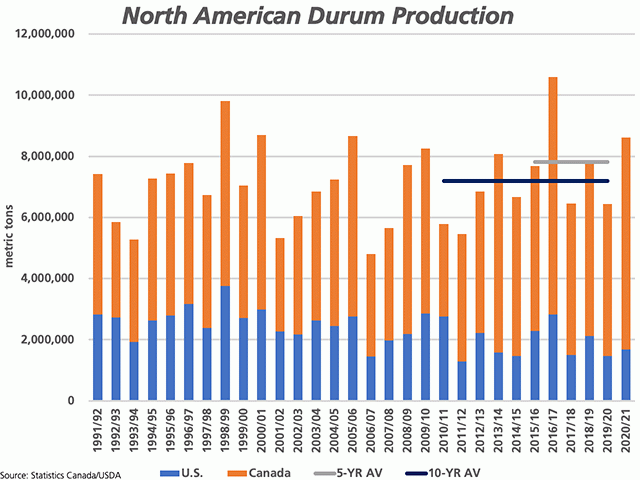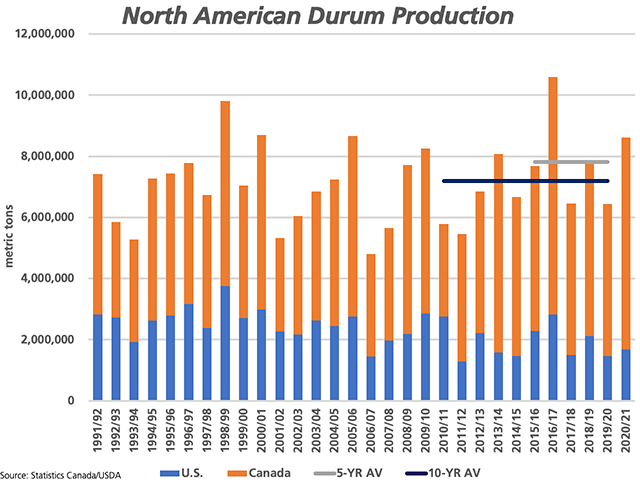Canada Markets
A Look at Canada-US Durum Production
On Aug. 31, Statistics Canada estimated Canada's 2020 durum production at 6.926 million metric tons, up 1.949 mmt, or 39.2%, from 2019 -- that's 15.5% above the five-year average and would be the largest produced in four years. This estimate was above expectations and would be Canada's second-largest crop ever produced, next to the 7.8 mmt produced in 2016.
It is interesting to note that over the past five years, Statistics Canada's final November durum production estimate averaged 17.7% higher than the July estimated, which has historically been a survey-based estimate, while averaging 6.9% higher than the August model-based estimate. Only once in the past five years was an estimated durum crop size higher than the November estimate, which was the model-based estimate in 2019 which was marginally higher than the final Nov. estimate.
When this volume is combined with USDA's estimates for the United States, as seen on the attached chart, total production would reach 8.6 mmt in 2020-21, also the largest combined crop in four years and 2.2 mmt higher than achieved in 2019-20.
P[L1] D[0x0] M[300x250] OOP[F] ADUNIT[] T[]
Canadian traders seemed to shake off the huge durum crop estimate released by Statistics Canada on Monday. Despite this news, pdqinfo.ca reported Monday's durum prices higher across the six regions of the Prairies monitored, ranging from $1.41/metric ton to $2.81/mt higher, averaging $2.10/mt. This is also on a day when the Canadian dollar strengthened 39 basis points to reach a 33-week high. This was the first higher spot bid reported in five days.
Sept. 1 price data showed further gains in two of the six prairie regions, with a modest gain of $0.98/mt in southern Alberta and a gain of $0.30/mt in western Manitoba, which may indicate shipping demand in both an eastern and western direction. The other four regions reported modest losses of $0.13/mt to $0.73/mt, with the average of the six regions pointing to a modest $0.10/mt drop in price.
As of Aug. 31, the southern Alberta bid was reported at a level 5.4% higher than the four-year average, southwest Saskatchewan 6.3% higher than average and southeast Sask. 7.1% above average.
Perhaps it is all about demand. While official July exports are not yet available, we look at week 3 Canadian Grain Commission data that shows 231,000 mt exported over the first three weeks of the crop year. While this is down 14,400 mt, or 5.9% from the same three-week period in 2019, it is 77,100 mt or 50% higher than the five-year average for this period.
As well, weekly European data shows 570,000 mt of durum imported into the E.U. in the first nine weeks of their crop year as of Aug. 31, a volume that is 152% higher than the same period in 2019-20 and 1,002% higher than the same period in 2018-19. The latest E.U. production forecasts, updated on Aug.27, shows a preliminary estimate of E.U. production at 7.189 mmt, down for a fourth straight year. This volume is down 16.9% from the five-year trimmed average of 8.655 mmt, a calculation that removes a certain percentage of the lowest and highest data points each year, meant to remove outlier data.
Of the 2020-21 E.U. crop year imports, 67.9% or 387,096 mt has originated from Canada with a further 26.2% or 149,433 mt from the U.S. The volume sourced from Canada is up 142.9% year-over-year.
Cliff Jamieson can be reached at cliff.jamieson@dtn.com
Follow him on Twitter @Cliff Jamieson
© (c) Copyright 2020 DTN, LLC. All rights reserved.





Comments
To comment, please Log In or Join our Community .